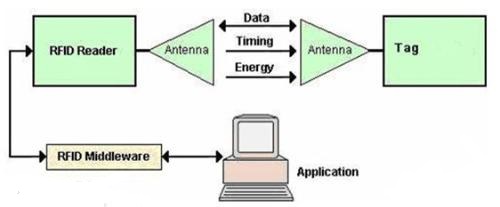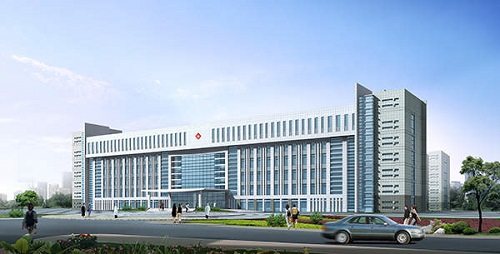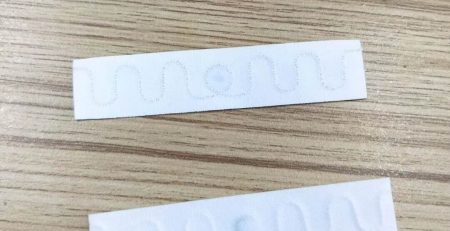What is RFID systems?
RFID technology has developed rapidly in recent years. We often use RFID technology, then what is the principle of RFID systems, how does RFID systems work? Today STARNFC takes everyone to know about RFID systems.
RFID system components
In the specific application process of RFID system, the composition of RFID system will be different according to different application purposes and application environment. However, from the working principle of RFID system, the system generally consists of signal transmitter, signal receiver, transmission and the receiving antenna is composed of several parts.
- Signal Transmitter In an RFID system, the signal transmitter will exist in different forms for different application purposes, and the typical form is a tag (TAG). The tag is equivalent to the bar code symbol in the bar code technology, and is used to store the information that needs to be identified and transmitted. In addition, unlike the bar code, the tag must be able to actively transmit the stored information automatically or under the action of an external force. Tags are typically low electrical integrated circuits with coils, antennas, memory and control systems.
- Signal Receiver In an RFID system, a signal receiver is generally called a reader. The complexity of the reader is significantly different depending on the type of tag supported and the function being completed. The basic function of the reader is to provide a way to transfer data with the tag. In addition, the reader provides fairly complex signal state control, parity error checking and correction functions. In addition to storing the information to be transmitted, the tag must also contain certain additional information, such as error check information. The identification data information and the additional information are compiled according to a certain structure and sent out in a specific order. The reader controls the transmission of the data stream by receiving additional information. Once the information arriving at the reader is correctly received and deciphered, the reader determines whether the transmitter needs to retransmit the transmitted signal once, or knows that the transmitter stops signaling, which is the “command response protocol”. Using this protocol, even if you read multiple tags in a short time and in a small space, you can effectively prevent the “spoofing problem”.
- The antenna is a transmitting and receiving device that transmits data between the tag and the reader. In practical applications, in addition to system power, the shape and relative position of the antenna will also affect the transmission and reception of data. System antenna design and installation requires a professional.
RFID system workflow
The reader transmits a certain frequency of the radio frequency signal through the transmitting antenna, and generates an induced current when the radio frequency card enters the working area of the transmitting antenna, and the energy obtained by the radio frequency card is activated; the radio frequency card transmits the information such as its own code through the built-in transmitting antenna of the card; the system receiving antenna Receiving the carrier signal sent from the RF card, transmitting it to the reader via the antenna adjuster, the reader demodulates and decodes the received signal and sends it to the background main system for related processing; the main system judges the card according to the logic operation Legitimacy, corresponding processing and control for different settings, issuing command signals to control actuator actions.
Different in coupling mode (inductor-electromagnetic), communication flow (FDX, HDX, SEQ), data transmission method from RF card to reader (load modulation, backscatter, higher harmonics) and frequency range The contactless transmission method is fundamentally different, but all readers are similar in terms of functional principle and thus the design and construction. All readers can be simplified into two basic modules: high frequency interface and control unit. The high frequency interface includes a transmitter and a receiver, the functions of which include: generating high frequency transmit power to activate the radio frequency card and providing energy; modulating the transmit signal for transmitting data to the radio frequency card; receiving and demodulating the radio frequency card from the radio frequency card High frequency signal. There are some differences in the design of high frequency interfaces for different RFID systems.
RFID system application
The main working frequency and effective recognition distance of the RFID system are: low frequency 125-134kHz, recognition distance <0.5m; high frequency 13.56MHz, recognition distance less than 1m: UHF 902-928MHz, recognition distance 4-8m: microwave is 2.54GHz The recognition distance can reach 100m. RFID can be identified from a few centimeters to a dozen meters, and the application range is very wide. For example, the second generation ID card in China uses 13.56MHz.
RFID system helps hospitals monitor drug application after discharge from hospital
When a patient is discharged from the hospital, the doctor usually prescribes one or more prescription drugs for the patient who must take it on time and self-track the medication. However, it is often the case that some patients do not take medication according to their doctor’s advice and eventually have to return to hospital for treatment. The hospital hopes to have an automated solution to this problem, including mobile phones with RFID readers, labeled bottles, and a web server that remotely manages individual prescription drugs. The goal of the hospital is to reduce the chances of heart disease patients returning to the hospital because they do not insist on taking the prescribed medication. The RFID system can help the hospital monitor the patient’s medication after discharge.
RFID systems help companies manage IT assets
Most of the enterprise’s management of IT assets uses one-dimensional bar codes to mark assets. However, bar code marking can not automatically track the location information of assets, which is not convenient for asset search. As a result of long use time, some assets of the enterprise are lost, and it takes a lot of inventory. The manpower check the book information and still can’t make the current asset list. At the same time, with the increase of the use time, the bar code is easy to fall off and become obscure, which is not conducive to asset management. Some companies still have classified assets, which have The company’s important data, employees will bring out the work area at will, it will create huge security risks. The RFID system can solve this problem very well.
STARNFC is the best supplier of RFID cards and RFID tags, you can visit our products here:
https://www.starnfc.com/shop/
If you have any questions, please feel free to contact us.




